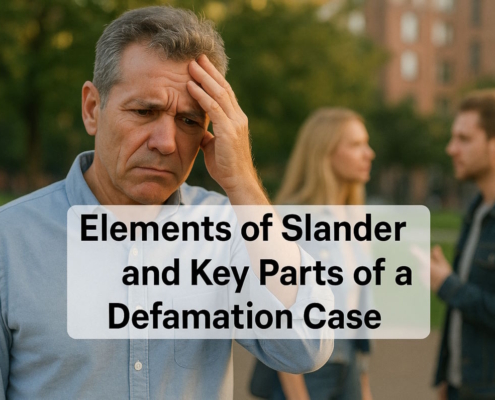What does second-degree murder mean?
You have probably heard of first-degree murder from the dozens of popular legal shows like Law and Order. But what about second-degree murder? This charge is less known. The key difference between the two is that second-degree murder does not involve premeditation. This means the murder was not planned ahead of time. By contrast, first-degree murder means that the accused purportedly killed someone after carefully planning the crime.
Second-degree murder may be described as killing a person with what we call ‘malice aforethought.’ In plain English, this means that the crime was intentional. It could also be that the person behaved recklessly, thus carelessly endangering another’s life.
So, before we dive into a thorough discussion of second-degree murder, let’s review the basic facts about first-degree murder. As mentioned above, first-degree murder involves someone who planned and intended to kill someone. This means a first-degree charge requires both malice aforethought (intention) and premeditation (planning). How much planning is required to warrant a first-degree charge? It doesn’t matter, really. They might have planned it for months. Or, it could have happened an hour before when they went over in their mind how to kill the victim.
The difference in murder charges among states
Second-degree murder varies by definition in different states. The majority of states divide murder into separate degrees, though some states do not recognize the term ‘second-degree murder.’ What degree of murder someone is charged with comes down to the intent (or lack thereof) behind the killing. Under criminal law, guilt exists in varying degrees.
When it comes to sentencing, punishments again vary according to the specific state. In some cases, an individual may spend a year in prison, while another may get life.
Killing intentionally but without premeditation
The main point to remember with second-degree murder is that the perpetrator did not plan the crime. When the murder happens, the person either wants to severely hurt the victim or kill them. However, until that very moment, they had not planned to commit murder. This element of planning is what separates first- and second- degree murder.
How about an example? Picture a set of neighbors, Howard and Tom. Howard has planted a line of very ugly trees between their houses. Tom comes over to talk to Howard about ripping up the trees, but the discussion quickly descends into a screaming match. Furious, Howard grabs a nearby rifle and shoots Tom, who dies. Howard had no plan to kill Tom that day, but by shooting him, he certainly meant to maim or kill him. So, we have intention but not premeditation. Therefore, the prosecutors in this case would likely charge Howard with second-degree murder.
Now, what would happen if Tom provoked Howard in some way? If provocation is involved in their sudden argument, then Howard would probably be charged with voluntary manslaughter. The mitigating factor in this scenario is the notion of ‘heat of passion.’ Think of this as acting emotionally or otherwise out of character. In this instance, Howard would not receive as harsh a punishment as he would if he intended, clear-headed, to kill his neighbor.
Intent to hurt but not kill another
Let’s say someone just wants to hurt another person but is aware that death is a distinct possibility. This is another scenario that falls under the purview of second-degree murder.
To return to our example of Howard, Tom, and the ugly trees, imagine that Howard grabbed a hammer instead of a gun. He whacks Tom over the head with it, hoping to ‘knock some sense into him’ with a nasty bruise. Instead, Tom falls down dead. Now, Howard didn’t swing that hammer with the intent to kill his neighbor, but he did mean to hurt him. As a reasonable person, Howard knew that a hammer strike could certainly kill someone. Because of this, the charge would still be second-degree murder, even though his intention was not to kill.
Reckless indifference to human life
Second-degree murder has yet another variety. This happens when the perpetrator acts with extreme or reckless indifference to human life, causing someone to die. What does this mean? It suggests that the person completely ignored the chance that their actions could result in someone’s death.
Back to our buddies, Howard and Tom! No hammer this time. Instead, the sound of shouting and cursing has created a stir in the neighborhood, and everyone has grabbed a beer and come over to watch the fireworks.
Howard gets riled up and grabs his gun, which he unloads into the air above the crowd. While he does not point the weapon at his neighbors, a stray bullet strikes someone. It was not Howard’s intent to kill anyone. However, he did not consider the possible damage that his behavior might cause. This would be an example of reckless indifference to human life.
Another common example of this variety of second-degree murder would be a drunk driver killing someone with their car. In this situation, some states would charge the perpetrator with second-degree murder in addition to a DUI. We all know how dangerous drunk driving is, and therefore, the driver has shown a reckless indifference to human life.
It is important to note that regardless of whether a drunk driving death is second-degree murder or manslaughter, death caused by drunk driving is considered unlawful killing.
Felony murder
But what happens if an unintentional death takes place in the course of another crime? We call this situation ‘felony murder.’ Certain states consider this to be a variety of second-degree murder, but others classify it as first-degree murder.
Notably, you can be found guilty of felony murder even if you did not kill the person yourself. Let’s go back to our problematic friends Howard and Tom, and this time make them robbers. Our friends go into a 7-11 with the intention to rob the store owner at gunpoint (Howard brings his rifle). Armed robbery is considered a felony.
The store owner puts up a fight, and trigger-happy Howard shoots him. Just because Howard committed the murder does not mean Tom gets off scot-free. Rather, a jury could find Tom guilty of murder in the second degree.
Why is this? Tom took part in the robbery willingly, and he knew that there was a possibility someone would be killed – why else would they bring a gun? Thus, under the felony murder doctrine, Tom can be held responsible for the store owner’s death.
Punishments for second-degree murder
The punishments for second-degree murder will vary according to the particular state. First-degree murder is more serious than second-degree murder, of course. However, second-degree murder can still land you in prison for life. That said, you won’t face the death penalty for second-degree murder, whatever state you are in.
Here are some example sentences for second-degree murder in different U.S. states:
- Illinois: The state imposes a sentence of four to twenty years in prison.
- Louisiana: Way harsher down here. If you were an adult when the crime happened, you’re looking at mandatory life in prison with no chance of parole. If you were a minor, you might get parole after 25 years.
- Virginia: Five to forty years in the state for lovers.
If you find yourself tried in federal court, you will be looking at years to life in prison.
Mitigating and aggravating factors
Certain crucial elements come into play in any criminal case, including second-degree murder trials. If someone is convicted of this crime, you can bet there will be mitigating and aggravating factors.
What’s the difference, you may ask? An aggravating factor would result in a longer sentence. By contrast, a mitigating factor means a less harsh sentence. The judge will use these factors to determine the length of the punishment.
Let’s take a gander at some aggravating factors:
- The use of a deadly weapon like a gun.
- If the assailant killed the victim based on their race, gender, sexual orientation, age, religion, or ancestry.
- The way the person died was particularly brutal or cruel.
- The perpetrator committed similar crimes before.
Now for some mitigating factors:
- The defendant is remorseful, expressing regret over the crime.
- Minimal or no criminal record.
- Physical or mental illness
Second-degree murder possible defenses
Just as it is important to understand what constitutes second-degree murder and how it is sentenced, it is also good to know how to defend against such a charge. Here are a few common defenses you’ll see presented in court:
1. Actual innocence
The defendant may claim to be innocent, saying that eyewitnesses were mistaken. Picture Geoff, a bald man walking home from the bakery with a delicious donut. He passes by an alleyway where an argument is happening, and someone gets shot. A bald man runs away with a gun in his hand. Frightened, Geoff runs home. Later, witnesses say that it was a bald man who fired the shot, and fingers point at Geoff. “You’ve got the wrong bald man!” says Geoff in court.
2. Self-defense
If you feel your life is being threatened, you have the right to defend yourself using the same amount of force. If someone dies because you defended yourself, it is legally caused a justifiable homicide. It can happen, however, that someone claiming self-defense did not act appropriately under the circumstances.
In this case, they may get a second-degree murder charge or perhaps voluntary manslaughter. Picture getting into a fight with someone outside a bar. They fall down, and you proceed to stomp on their head several times, killing them. This would not qualify as self-defense. But let’s say someone comes at you with a knife, so you stab them to keep them from killing you. This is a valid case of self-defense.
3. Insanity
For a person to commit a crime, they need to have the necessary state of mind, or what is known as mens rea in legal jargon. So, if someone does not recognize the difference between right and wrong due to a serious mental illness, they may be found not guilty due to insanity. If the perpetrator did not understand the gravity of what they were doing, they could also be found legally ‘insane.’ In some states, there is a separate option. In addition to the option of not guilty by reason of insanity, there is ‘guilty but mentally ill.’
4. Intoxication
In most circumstances, you cannot use drunkenness as a legitimate defense. It can be hard to prove unwilling intoxication, but this may qualify as a defense. If drunkenness prevented someone from forming the necessary intent to kill, they may be found not guilty.
Contact a lawyer
Regardless, if you are facing a charge of second-degree murder, you should get legal help right away from a seasoned defense lawyer. They can help you prepare a strong defense.






























